LCBS5042: Business Across Cultures - Tata Steel Challenges Report
VerifiedAdded on 2022/11/16
|14
|4337
|267
Report
AI Summary
This report delves into the cultural challenges faced by Tata Steel, focusing on its acquisition of Corus in the UK. It begins with an introduction to the complexities of managing cross-border cultural differences and the impact of national culture on organizational behavior. The report then explores Hofstede's model of national culture, outlining its six dimensions and their influence on business practices, while also acknowledging criticisms of the model. A key section analyzes the specific cultural challenges Tata Steel encountered, particularly the differences between Indian and UK cultures, including power distance, individualism, uncertainty avoidance, and long-term orientation. The report highlights how these cultural discrepancies affected operations and team management, using the example of Corus's UK and Dutch plants to illustrate the impact on profitability and employee relations. Finally, the report underscores the importance of understanding cultural dimensions for successful international business ventures and provides valuable insights into the practical implications of cultural differences within an organization.
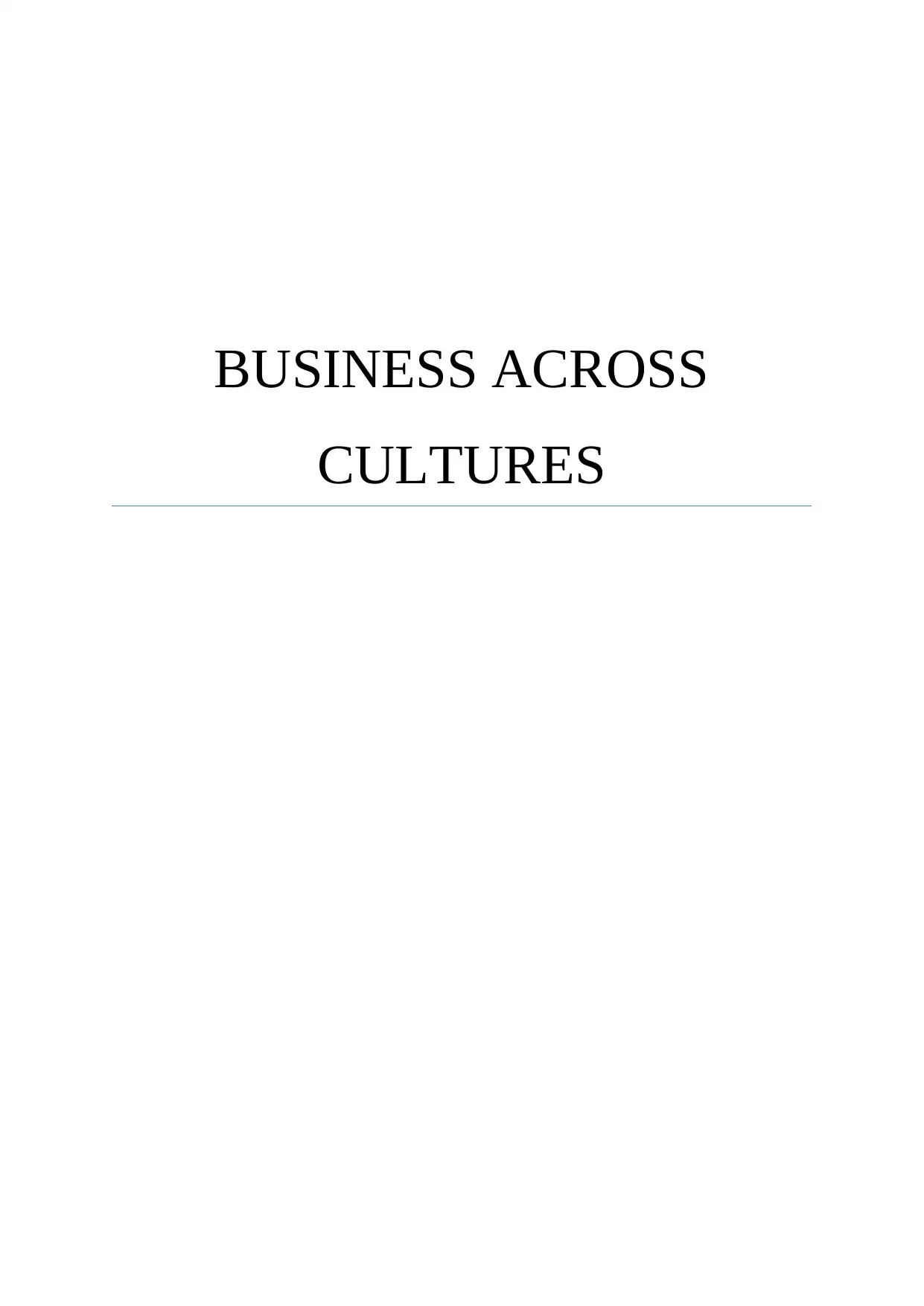
BUSINESS ACROSS
CULTURES
CULTURES
Paraphrase This Document
Need a fresh take? Get an instant paraphrase of this document with our AI Paraphraser
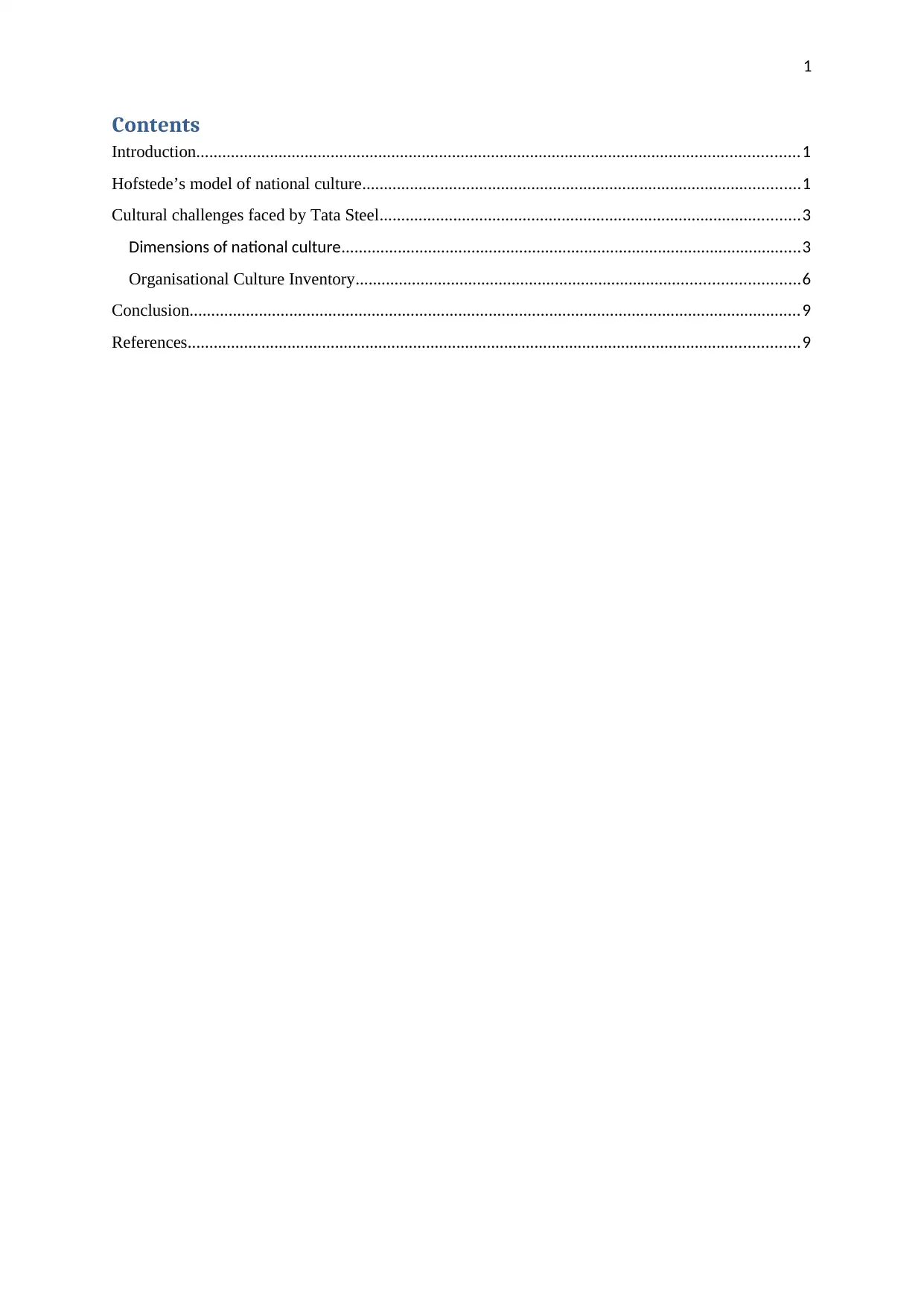
1
Contents
Introduction...........................................................................................................................................1
Hofstede’s model of national culture.....................................................................................................1
Cultural challenges faced by Tata Steel.................................................................................................3
Dimensions of national culture..........................................................................................................3
Organisational Culture Inventory......................................................................................................6
Conclusion.............................................................................................................................................9
References.............................................................................................................................................9
Contents
Introduction...........................................................................................................................................1
Hofstede’s model of national culture.....................................................................................................1
Cultural challenges faced by Tata Steel.................................................................................................3
Dimensions of national culture..........................................................................................................3
Organisational Culture Inventory......................................................................................................6
Conclusion.............................................................................................................................................9
References.............................................................................................................................................9
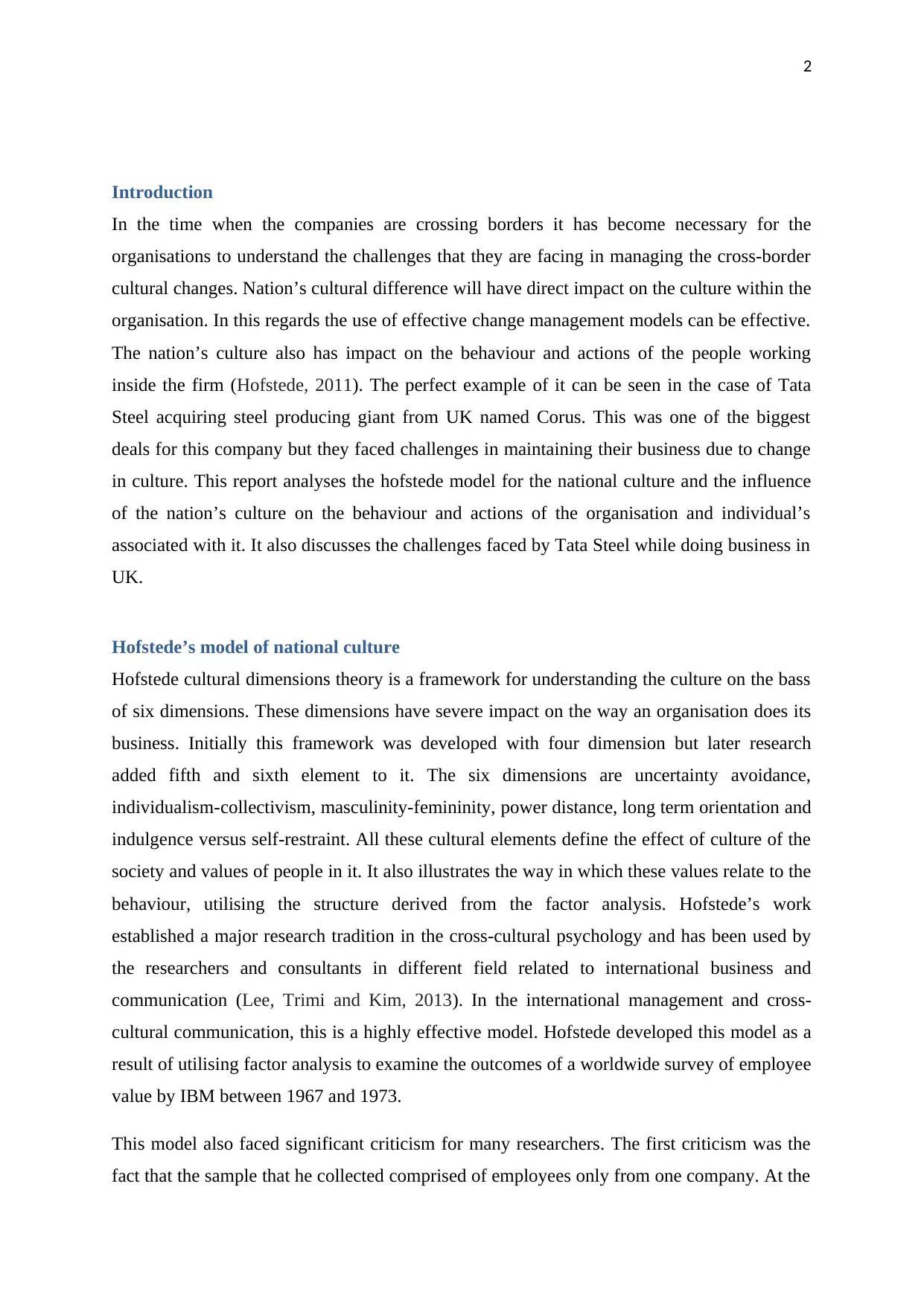
2
Introduction
In the time when the companies are crossing borders it has become necessary for the
organisations to understand the challenges that they are facing in managing the cross-border
cultural changes. Nation’s cultural difference will have direct impact on the culture within the
organisation. In this regards the use of effective change management models can be effective.
The nation’s culture also has impact on the behaviour and actions of the people working
inside the firm (Hofstede, 2011). The perfect example of it can be seen in the case of Tata
Steel acquiring steel producing giant from UK named Corus. This was one of the biggest
deals for this company but they faced challenges in maintaining their business due to change
in culture. This report analyses the hofstede model for the national culture and the influence
of the nation’s culture on the behaviour and actions of the organisation and individual’s
associated with it. It also discusses the challenges faced by Tata Steel while doing business in
UK.
Hofstede’s model of national culture
Hofstede cultural dimensions theory is a framework for understanding the culture on the bass
of six dimensions. These dimensions have severe impact on the way an organisation does its
business. Initially this framework was developed with four dimension but later research
added fifth and sixth element to it. The six dimensions are uncertainty avoidance,
individualism-collectivism, masculinity-femininity, power distance, long term orientation and
indulgence versus self-restraint. All these cultural elements define the effect of culture of the
society and values of people in it. It also illustrates the way in which these values relate to the
behaviour, utilising the structure derived from the factor analysis. Hofstede’s work
established a major research tradition in the cross-cultural psychology and has been used by
the researchers and consultants in different field related to international business and
communication (Lee, Trimi and Kim, 2013). In the international management and cross-
cultural communication, this is a highly effective model. Hofstede developed this model as a
result of utilising factor analysis to examine the outcomes of a worldwide survey of employee
value by IBM between 1967 and 1973.
This model also faced significant criticism for many researchers. The first criticism was the
fact that the sample that he collected comprised of employees only from one company. At the
Introduction
In the time when the companies are crossing borders it has become necessary for the
organisations to understand the challenges that they are facing in managing the cross-border
cultural changes. Nation’s cultural difference will have direct impact on the culture within the
organisation. In this regards the use of effective change management models can be effective.
The nation’s culture also has impact on the behaviour and actions of the people working
inside the firm (Hofstede, 2011). The perfect example of it can be seen in the case of Tata
Steel acquiring steel producing giant from UK named Corus. This was one of the biggest
deals for this company but they faced challenges in maintaining their business due to change
in culture. This report analyses the hofstede model for the national culture and the influence
of the nation’s culture on the behaviour and actions of the organisation and individual’s
associated with it. It also discusses the challenges faced by Tata Steel while doing business in
UK.
Hofstede’s model of national culture
Hofstede cultural dimensions theory is a framework for understanding the culture on the bass
of six dimensions. These dimensions have severe impact on the way an organisation does its
business. Initially this framework was developed with four dimension but later research
added fifth and sixth element to it. The six dimensions are uncertainty avoidance,
individualism-collectivism, masculinity-femininity, power distance, long term orientation and
indulgence versus self-restraint. All these cultural elements define the effect of culture of the
society and values of people in it. It also illustrates the way in which these values relate to the
behaviour, utilising the structure derived from the factor analysis. Hofstede’s work
established a major research tradition in the cross-cultural psychology and has been used by
the researchers and consultants in different field related to international business and
communication (Lee, Trimi and Kim, 2013). In the international management and cross-
cultural communication, this is a highly effective model. Hofstede developed this model as a
result of utilising factor analysis to examine the outcomes of a worldwide survey of employee
value by IBM between 1967 and 1973.
This model also faced significant criticism for many researchers. The first criticism was the
fact that the sample that he collected comprised of employees only from one company. At the
⊘ This is a preview!⊘
Do you want full access?
Subscribe today to unlock all pages.

Trusted by 1+ million students worldwide
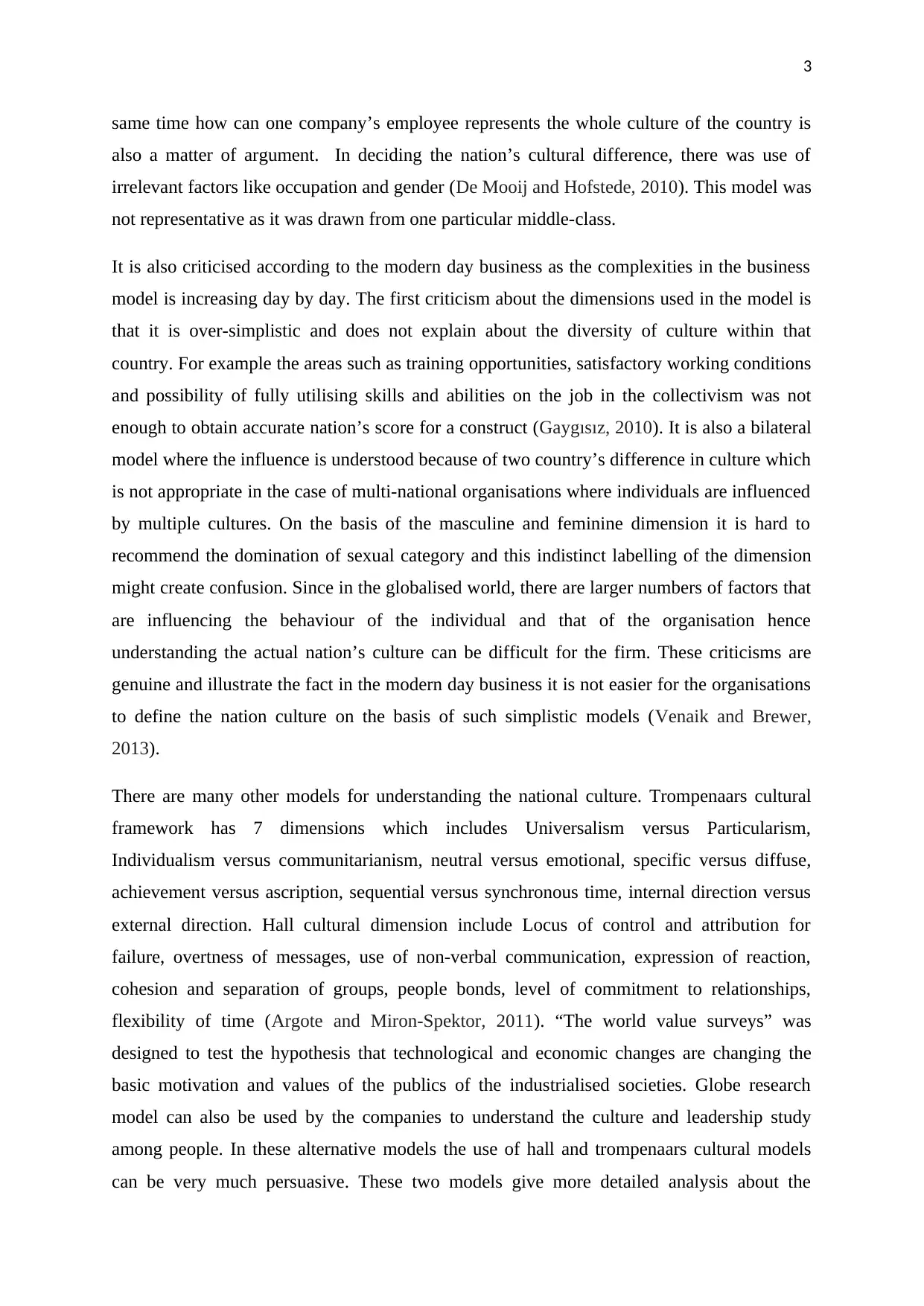
3
same time how can one company’s employee represents the whole culture of the country is
also a matter of argument. In deciding the nation’s cultural difference, there was use of
irrelevant factors like occupation and gender (De Mooij and Hofstede, 2010). This model was
not representative as it was drawn from one particular middle-class.
It is also criticised according to the modern day business as the complexities in the business
model is increasing day by day. The first criticism about the dimensions used in the model is
that it is over-simplistic and does not explain about the diversity of culture within that
country. For example the areas such as training opportunities, satisfactory working conditions
and possibility of fully utilising skills and abilities on the job in the collectivism was not
enough to obtain accurate nation’s score for a construct (Gaygısız, 2010). It is also a bilateral
model where the influence is understood because of two country’s difference in culture which
is not appropriate in the case of multi-national organisations where individuals are influenced
by multiple cultures. On the basis of the masculine and feminine dimension it is hard to
recommend the domination of sexual category and this indistinct labelling of the dimension
might create confusion. Since in the globalised world, there are larger numbers of factors that
are influencing the behaviour of the individual and that of the organisation hence
understanding the actual nation’s culture can be difficult for the firm. These criticisms are
genuine and illustrate the fact in the modern day business it is not easier for the organisations
to define the nation culture on the basis of such simplistic models (Venaik and Brewer,
2013).
There are many other models for understanding the national culture. Trompenaars cultural
framework has 7 dimensions which includes Universalism versus Particularism,
Individualism versus communitarianism, neutral versus emotional, specific versus diffuse,
achievement versus ascription, sequential versus synchronous time, internal direction versus
external direction. Hall cultural dimension include Locus of control and attribution for
failure, overtness of messages, use of non-verbal communication, expression of reaction,
cohesion and separation of groups, people bonds, level of commitment to relationships,
flexibility of time (Argote and Miron-Spektor, 2011). “The world value surveys” was
designed to test the hypothesis that technological and economic changes are changing the
basic motivation and values of the publics of the industrialised societies. Globe research
model can also be used by the companies to understand the culture and leadership study
among people. In these alternative models the use of hall and trompenaars cultural models
can be very much persuasive. These two models give more detailed analysis about the
same time how can one company’s employee represents the whole culture of the country is
also a matter of argument. In deciding the nation’s cultural difference, there was use of
irrelevant factors like occupation and gender (De Mooij and Hofstede, 2010). This model was
not representative as it was drawn from one particular middle-class.
It is also criticised according to the modern day business as the complexities in the business
model is increasing day by day. The first criticism about the dimensions used in the model is
that it is over-simplistic and does not explain about the diversity of culture within that
country. For example the areas such as training opportunities, satisfactory working conditions
and possibility of fully utilising skills and abilities on the job in the collectivism was not
enough to obtain accurate nation’s score for a construct (Gaygısız, 2010). It is also a bilateral
model where the influence is understood because of two country’s difference in culture which
is not appropriate in the case of multi-national organisations where individuals are influenced
by multiple cultures. On the basis of the masculine and feminine dimension it is hard to
recommend the domination of sexual category and this indistinct labelling of the dimension
might create confusion. Since in the globalised world, there are larger numbers of factors that
are influencing the behaviour of the individual and that of the organisation hence
understanding the actual nation’s culture can be difficult for the firm. These criticisms are
genuine and illustrate the fact in the modern day business it is not easier for the organisations
to define the nation culture on the basis of such simplistic models (Venaik and Brewer,
2013).
There are many other models for understanding the national culture. Trompenaars cultural
framework has 7 dimensions which includes Universalism versus Particularism,
Individualism versus communitarianism, neutral versus emotional, specific versus diffuse,
achievement versus ascription, sequential versus synchronous time, internal direction versus
external direction. Hall cultural dimension include Locus of control and attribution for
failure, overtness of messages, use of non-verbal communication, expression of reaction,
cohesion and separation of groups, people bonds, level of commitment to relationships,
flexibility of time (Argote and Miron-Spektor, 2011). “The world value surveys” was
designed to test the hypothesis that technological and economic changes are changing the
basic motivation and values of the publics of the industrialised societies. Globe research
model can also be used by the companies to understand the culture and leadership study
among people. In these alternative models the use of hall and trompenaars cultural models
can be very much persuasive. These two models give more detailed analysis about the
Paraphrase This Document
Need a fresh take? Get an instant paraphrase of this document with our AI Paraphraser
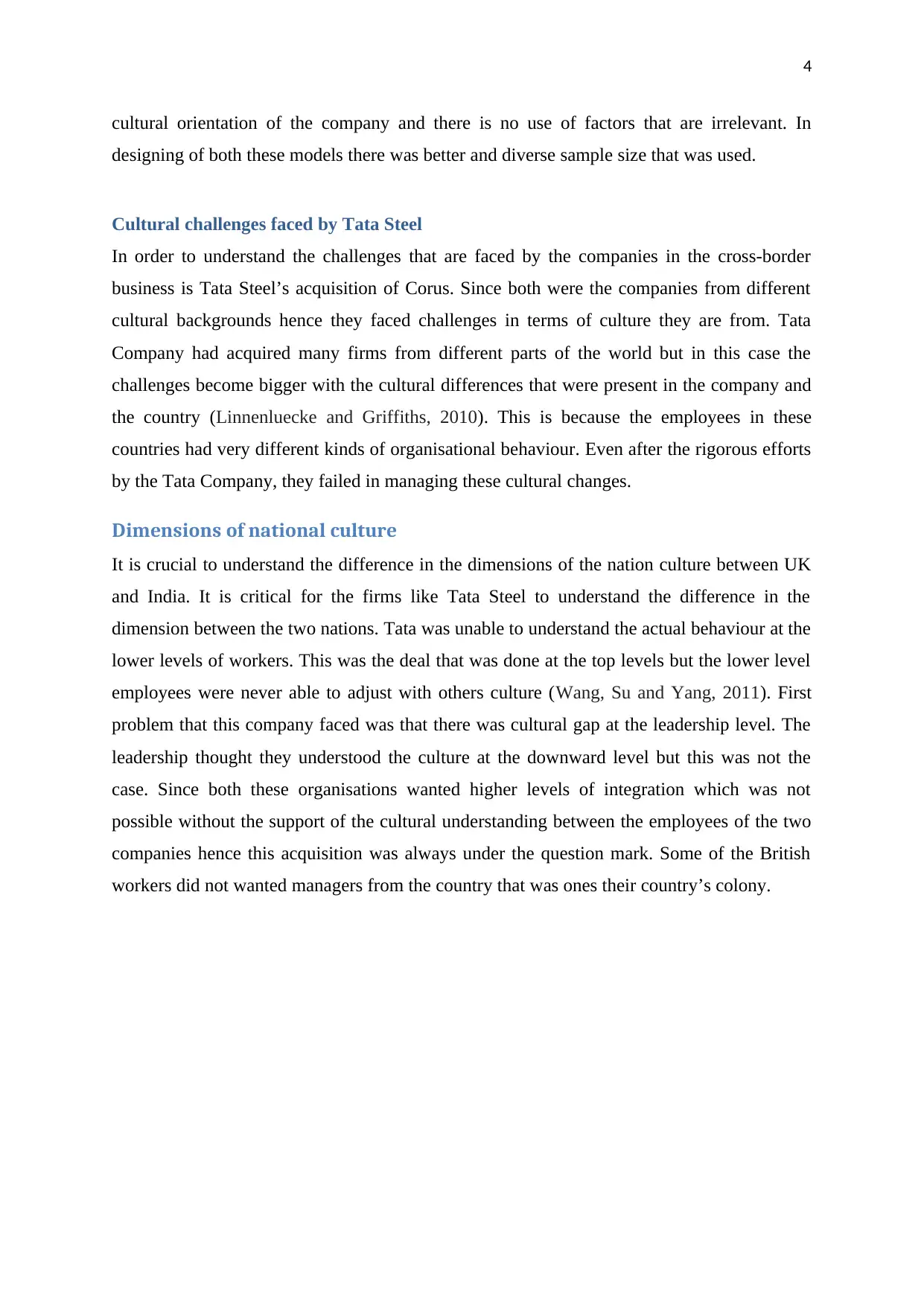
4
cultural orientation of the company and there is no use of factors that are irrelevant. In
designing of both these models there was better and diverse sample size that was used.
Cultural challenges faced by Tata Steel
In order to understand the challenges that are faced by the companies in the cross-border
business is Tata Steel’s acquisition of Corus. Since both were the companies from different
cultural backgrounds hence they faced challenges in terms of culture they are from. Tata
Company had acquired many firms from different parts of the world but in this case the
challenges become bigger with the cultural differences that were present in the company and
the country (Linnenluecke and Griffiths, 2010). This is because the employees in these
countries had very different kinds of organisational behaviour. Even after the rigorous efforts
by the Tata Company, they failed in managing these cultural changes.
Dimensions of national culture
It is crucial to understand the difference in the dimensions of the nation culture between UK
and India. It is critical for the firms like Tata Steel to understand the difference in the
dimension between the two nations. Tata was unable to understand the actual behaviour at the
lower levels of workers. This was the deal that was done at the top levels but the lower level
employees were never able to adjust with others culture (Wang, Su and Yang, 2011). First
problem that this company faced was that there was cultural gap at the leadership level. The
leadership thought they understood the culture at the downward level but this was not the
case. Since both these organisations wanted higher levels of integration which was not
possible without the support of the cultural understanding between the employees of the two
companies hence this acquisition was always under the question mark. Some of the British
workers did not wanted managers from the country that was ones their country’s colony.
cultural orientation of the company and there is no use of factors that are irrelevant. In
designing of both these models there was better and diverse sample size that was used.
Cultural challenges faced by Tata Steel
In order to understand the challenges that are faced by the companies in the cross-border
business is Tata Steel’s acquisition of Corus. Since both were the companies from different
cultural backgrounds hence they faced challenges in terms of culture they are from. Tata
Company had acquired many firms from different parts of the world but in this case the
challenges become bigger with the cultural differences that were present in the company and
the country (Linnenluecke and Griffiths, 2010). This is because the employees in these
countries had very different kinds of organisational behaviour. Even after the rigorous efforts
by the Tata Company, they failed in managing these cultural changes.
Dimensions of national culture
It is crucial to understand the difference in the dimensions of the nation culture between UK
and India. It is critical for the firms like Tata Steel to understand the difference in the
dimension between the two nations. Tata was unable to understand the actual behaviour at the
lower levels of workers. This was the deal that was done at the top levels but the lower level
employees were never able to adjust with others culture (Wang, Su and Yang, 2011). First
problem that this company faced was that there was cultural gap at the leadership level. The
leadership thought they understood the culture at the downward level but this was not the
case. Since both these organisations wanted higher levels of integration which was not
possible without the support of the cultural understanding between the employees of the two
companies hence this acquisition was always under the question mark. Some of the British
workers did not wanted managers from the country that was ones their country’s colony.
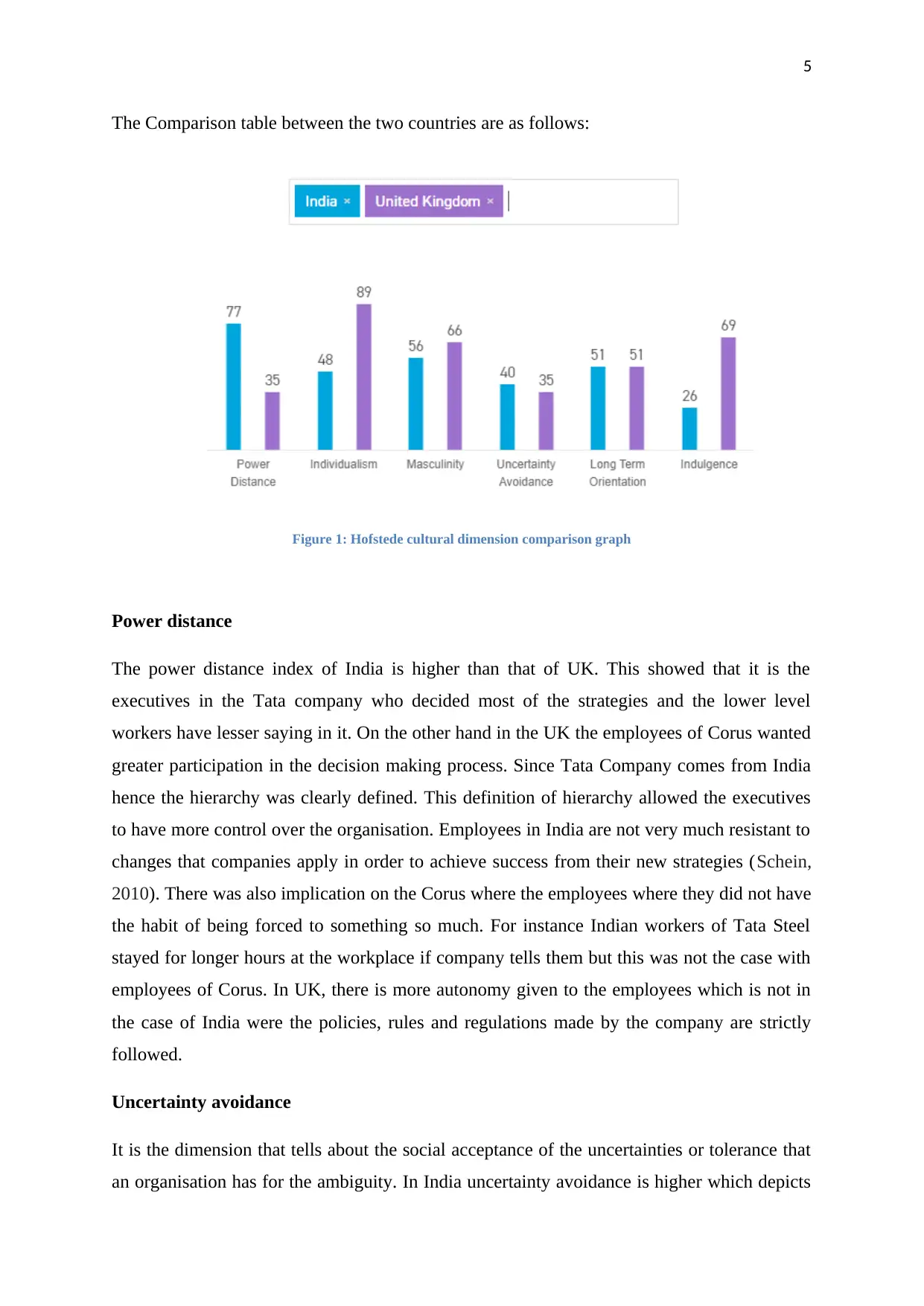
5
The Comparison table between the two countries are as follows:
Figure 1: Hofstede cultural dimension comparison graph
Power distance
The power distance index of India is higher than that of UK. This showed that it is the
executives in the Tata company who decided most of the strategies and the lower level
workers have lesser saying in it. On the other hand in the UK the employees of Corus wanted
greater participation in the decision making process. Since Tata Company comes from India
hence the hierarchy was clearly defined. This definition of hierarchy allowed the executives
to have more control over the organisation. Employees in India are not very much resistant to
changes that companies apply in order to achieve success from their new strategies (Schein,
2010). There was also implication on the Corus where the employees where they did not have
the habit of being forced to something so much. For instance Indian workers of Tata Steel
stayed for longer hours at the workplace if company tells them but this was not the case with
employees of Corus. In UK, there is more autonomy given to the employees which is not in
the case of India were the policies, rules and regulations made by the company are strictly
followed.
Uncertainty avoidance
It is the dimension that tells about the social acceptance of the uncertainties or tolerance that
an organisation has for the ambiguity. In India uncertainty avoidance is higher which depicts
The Comparison table between the two countries are as follows:
Figure 1: Hofstede cultural dimension comparison graph
Power distance
The power distance index of India is higher than that of UK. This showed that it is the
executives in the Tata company who decided most of the strategies and the lower level
workers have lesser saying in it. On the other hand in the UK the employees of Corus wanted
greater participation in the decision making process. Since Tata Company comes from India
hence the hierarchy was clearly defined. This definition of hierarchy allowed the executives
to have more control over the organisation. Employees in India are not very much resistant to
changes that companies apply in order to achieve success from their new strategies (Schein,
2010). There was also implication on the Corus where the employees where they did not have
the habit of being forced to something so much. For instance Indian workers of Tata Steel
stayed for longer hours at the workplace if company tells them but this was not the case with
employees of Corus. In UK, there is more autonomy given to the employees which is not in
the case of India were the policies, rules and regulations made by the company are strictly
followed.
Uncertainty avoidance
It is the dimension that tells about the social acceptance of the uncertainties or tolerance that
an organisation has for the ambiguity. In India uncertainty avoidance is higher which depicts
⊘ This is a preview!⊘
Do you want full access?
Subscribe today to unlock all pages.

Trusted by 1+ million students worldwide
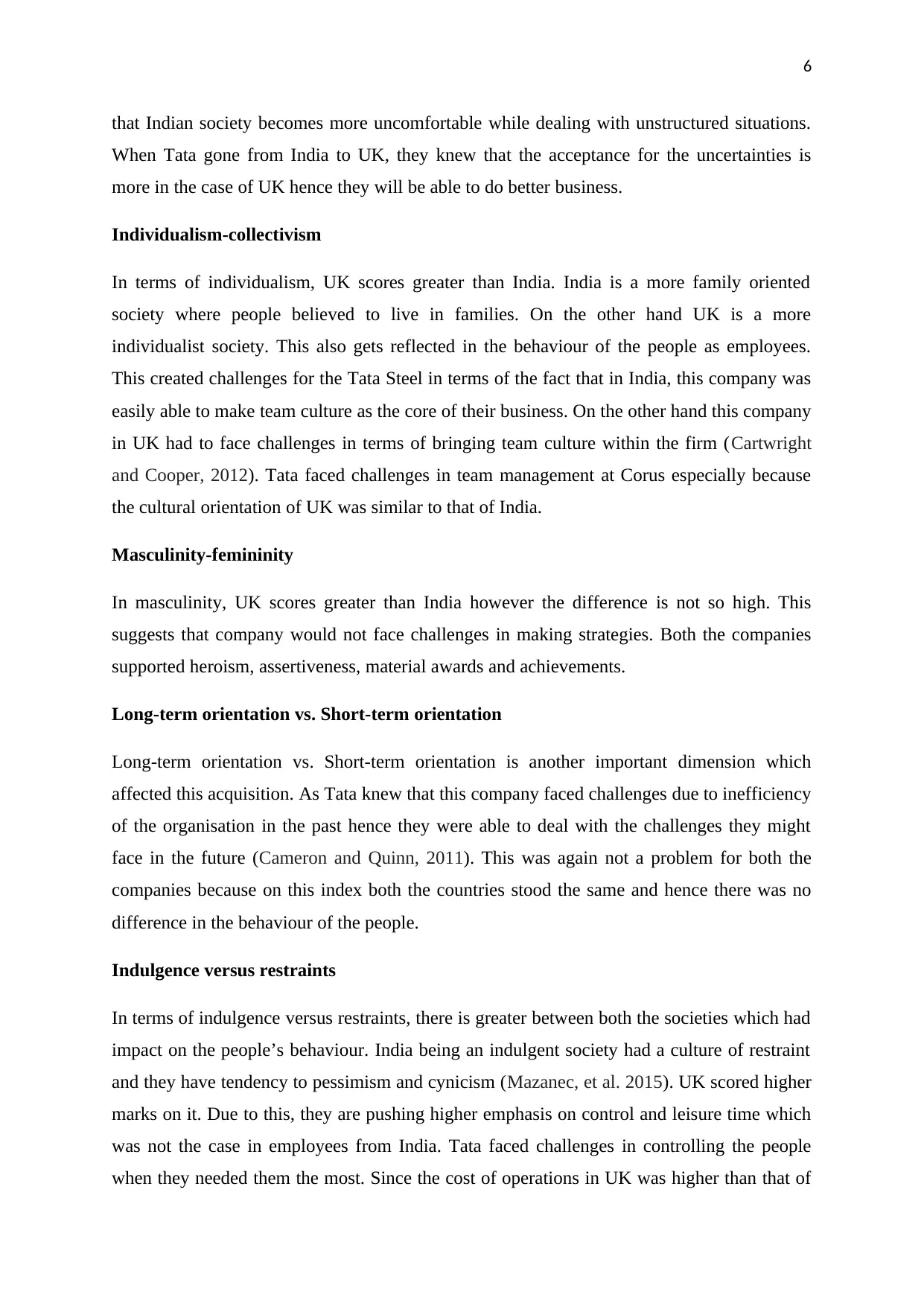
6
that Indian society becomes more uncomfortable while dealing with unstructured situations.
When Tata gone from India to UK, they knew that the acceptance for the uncertainties is
more in the case of UK hence they will be able to do better business.
Individualism-collectivism
In terms of individualism, UK scores greater than India. India is a more family oriented
society where people believed to live in families. On the other hand UK is a more
individualist society. This also gets reflected in the behaviour of the people as employees.
This created challenges for the Tata Steel in terms of the fact that in India, this company was
easily able to make team culture as the core of their business. On the other hand this company
in UK had to face challenges in terms of bringing team culture within the firm (Cartwright
and Cooper, 2012). Tata faced challenges in team management at Corus especially because
the cultural orientation of UK was similar to that of India.
Masculinity-femininity
In masculinity, UK scores greater than India however the difference is not so high. This
suggests that company would not face challenges in making strategies. Both the companies
supported heroism, assertiveness, material awards and achievements.
Long-term orientation vs. Short-term orientation
Long-term orientation vs. Short-term orientation is another important dimension which
affected this acquisition. As Tata knew that this company faced challenges due to inefficiency
of the organisation in the past hence they were able to deal with the challenges they might
face in the future (Cameron and Quinn, 2011). This was again not a problem for both the
companies because on this index both the countries stood the same and hence there was no
difference in the behaviour of the people.
Indulgence versus restraints
In terms of indulgence versus restraints, there is greater between both the societies which had
impact on the people’s behaviour. India being an indulgent society had a culture of restraint
and they have tendency to pessimism and cynicism (Mazanec, et al. 2015). UK scored higher
marks on it. Due to this, they are pushing higher emphasis on control and leisure time which
was not the case in employees from India. Tata faced challenges in controlling the people
when they needed them the most. Since the cost of operations in UK was higher than that of
that Indian society becomes more uncomfortable while dealing with unstructured situations.
When Tata gone from India to UK, they knew that the acceptance for the uncertainties is
more in the case of UK hence they will be able to do better business.
Individualism-collectivism
In terms of individualism, UK scores greater than India. India is a more family oriented
society where people believed to live in families. On the other hand UK is a more
individualist society. This also gets reflected in the behaviour of the people as employees.
This created challenges for the Tata Steel in terms of the fact that in India, this company was
easily able to make team culture as the core of their business. On the other hand this company
in UK had to face challenges in terms of bringing team culture within the firm (Cartwright
and Cooper, 2012). Tata faced challenges in team management at Corus especially because
the cultural orientation of UK was similar to that of India.
Masculinity-femininity
In masculinity, UK scores greater than India however the difference is not so high. This
suggests that company would not face challenges in making strategies. Both the companies
supported heroism, assertiveness, material awards and achievements.
Long-term orientation vs. Short-term orientation
Long-term orientation vs. Short-term orientation is another important dimension which
affected this acquisition. As Tata knew that this company faced challenges due to inefficiency
of the organisation in the past hence they were able to deal with the challenges they might
face in the future (Cameron and Quinn, 2011). This was again not a problem for both the
companies because on this index both the countries stood the same and hence there was no
difference in the behaviour of the people.
Indulgence versus restraints
In terms of indulgence versus restraints, there is greater between both the societies which had
impact on the people’s behaviour. India being an indulgent society had a culture of restraint
and they have tendency to pessimism and cynicism (Mazanec, et al. 2015). UK scored higher
marks on it. Due to this, they are pushing higher emphasis on control and leisure time which
was not the case in employees from India. Tata faced challenges in controlling the people
when they needed them the most. Since the cost of operations in UK was higher than that of
Paraphrase This Document
Need a fresh take? Get an instant paraphrase of this document with our AI Paraphraser
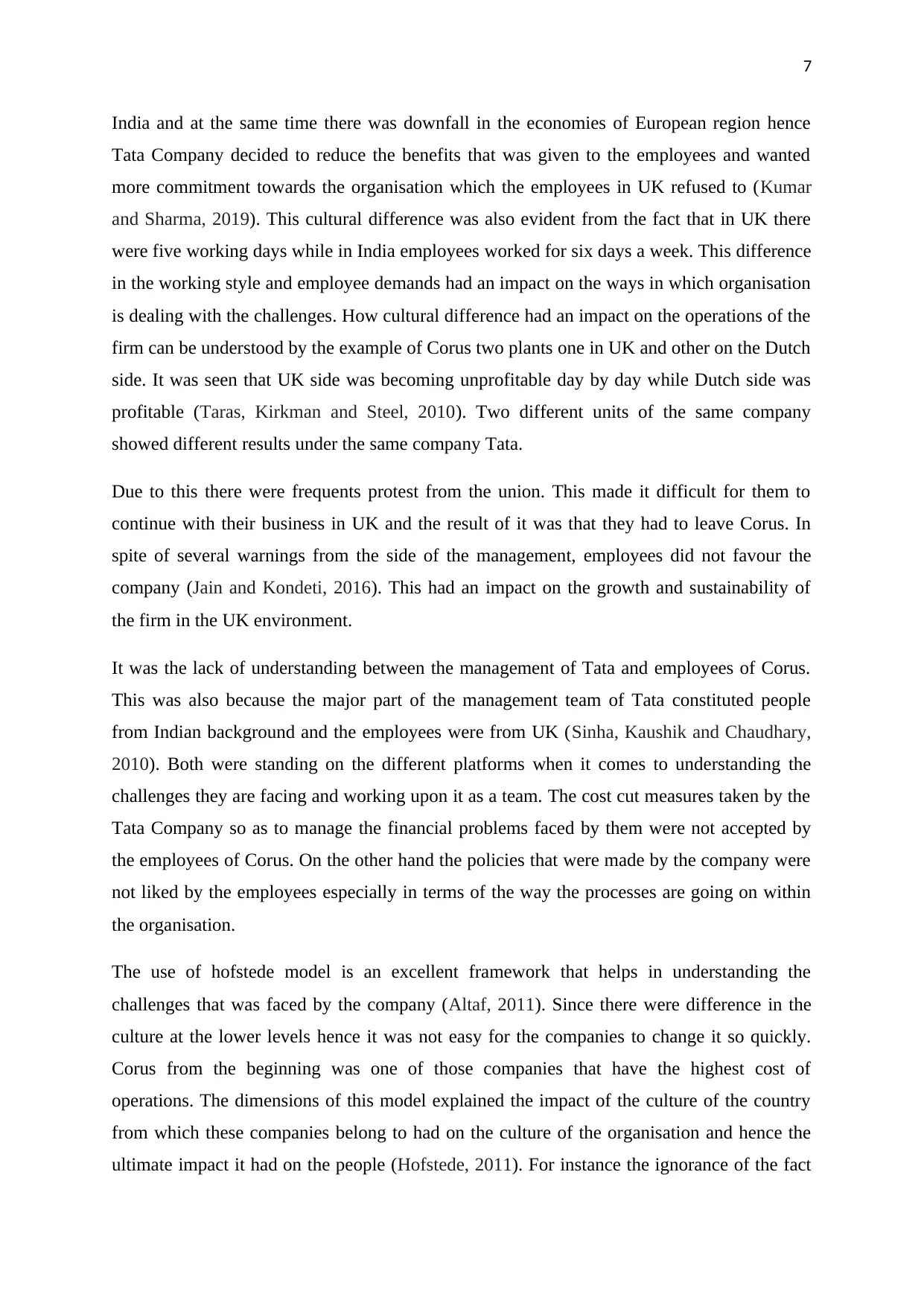
7
India and at the same time there was downfall in the economies of European region hence
Tata Company decided to reduce the benefits that was given to the employees and wanted
more commitment towards the organisation which the employees in UK refused to (Kumar
and Sharma, 2019). This cultural difference was also evident from the fact that in UK there
were five working days while in India employees worked for six days a week. This difference
in the working style and employee demands had an impact on the ways in which organisation
is dealing with the challenges. How cultural difference had an impact on the operations of the
firm can be understood by the example of Corus two plants one in UK and other on the Dutch
side. It was seen that UK side was becoming unprofitable day by day while Dutch side was
profitable (Taras, Kirkman and Steel, 2010). Two different units of the same company
showed different results under the same company Tata.
Due to this there were frequents protest from the union. This made it difficult for them to
continue with their business in UK and the result of it was that they had to leave Corus. In
spite of several warnings from the side of the management, employees did not favour the
company (Jain and Kondeti, 2016). This had an impact on the growth and sustainability of
the firm in the UK environment.
It was the lack of understanding between the management of Tata and employees of Corus.
This was also because the major part of the management team of Tata constituted people
from Indian background and the employees were from UK (Sinha, Kaushik and Chaudhary,
2010). Both were standing on the different platforms when it comes to understanding the
challenges they are facing and working upon it as a team. The cost cut measures taken by the
Tata Company so as to manage the financial problems faced by them were not accepted by
the employees of Corus. On the other hand the policies that were made by the company were
not liked by the employees especially in terms of the way the processes are going on within
the organisation.
The use of hofstede model is an excellent framework that helps in understanding the
challenges that was faced by the company (Altaf, 2011). Since there were difference in the
culture at the lower levels hence it was not easy for the companies to change it so quickly.
Corus from the beginning was one of those companies that have the highest cost of
operations. The dimensions of this model explained the impact of the culture of the country
from which these companies belong to had on the culture of the organisation and hence the
ultimate impact it had on the people (Hofstede, 2011). For instance the ignorance of the fact
India and at the same time there was downfall in the economies of European region hence
Tata Company decided to reduce the benefits that was given to the employees and wanted
more commitment towards the organisation which the employees in UK refused to (Kumar
and Sharma, 2019). This cultural difference was also evident from the fact that in UK there
were five working days while in India employees worked for six days a week. This difference
in the working style and employee demands had an impact on the ways in which organisation
is dealing with the challenges. How cultural difference had an impact on the operations of the
firm can be understood by the example of Corus two plants one in UK and other on the Dutch
side. It was seen that UK side was becoming unprofitable day by day while Dutch side was
profitable (Taras, Kirkman and Steel, 2010). Two different units of the same company
showed different results under the same company Tata.
Due to this there were frequents protest from the union. This made it difficult for them to
continue with their business in UK and the result of it was that they had to leave Corus. In
spite of several warnings from the side of the management, employees did not favour the
company (Jain and Kondeti, 2016). This had an impact on the growth and sustainability of
the firm in the UK environment.
It was the lack of understanding between the management of Tata and employees of Corus.
This was also because the major part of the management team of Tata constituted people
from Indian background and the employees were from UK (Sinha, Kaushik and Chaudhary,
2010). Both were standing on the different platforms when it comes to understanding the
challenges they are facing and working upon it as a team. The cost cut measures taken by the
Tata Company so as to manage the financial problems faced by them were not accepted by
the employees of Corus. On the other hand the policies that were made by the company were
not liked by the employees especially in terms of the way the processes are going on within
the organisation.
The use of hofstede model is an excellent framework that helps in understanding the
challenges that was faced by the company (Altaf, 2011). Since there were difference in the
culture at the lower levels hence it was not easy for the companies to change it so quickly.
Corus from the beginning was one of those companies that have the highest cost of
operations. The dimensions of this model explained the impact of the culture of the country
from which these companies belong to had on the culture of the organisation and hence the
ultimate impact it had on the people (Hofstede, 2011). For instance the ignorance of the fact
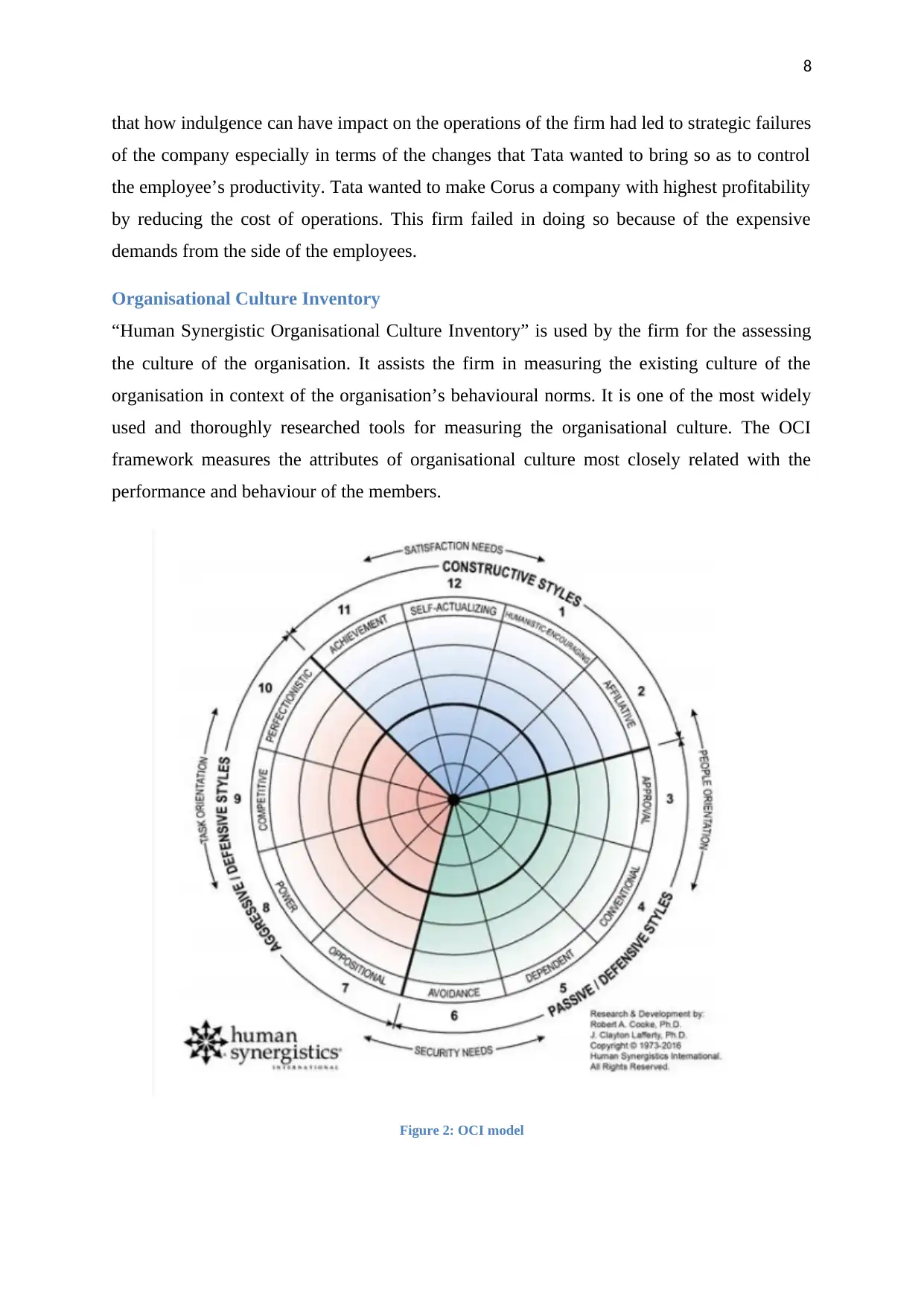
8
that how indulgence can have impact on the operations of the firm had led to strategic failures
of the company especially in terms of the changes that Tata wanted to bring so as to control
the employee’s productivity. Tata wanted to make Corus a company with highest profitability
by reducing the cost of operations. This firm failed in doing so because of the expensive
demands from the side of the employees.
Organisational Culture Inventory
“Human Synergistic Organisational Culture Inventory” is used by the firm for the assessing
the culture of the organisation. It assists the firm in measuring the existing culture of the
organisation in context of the organisation’s behavioural norms. It is one of the most widely
used and thoroughly researched tools for measuring the organisational culture. The OCI
framework measures the attributes of organisational culture most closely related with the
performance and behaviour of the members.
Figure 2: OCI model
that how indulgence can have impact on the operations of the firm had led to strategic failures
of the company especially in terms of the changes that Tata wanted to bring so as to control
the employee’s productivity. Tata wanted to make Corus a company with highest profitability
by reducing the cost of operations. This firm failed in doing so because of the expensive
demands from the side of the employees.
Organisational Culture Inventory
“Human Synergistic Organisational Culture Inventory” is used by the firm for the assessing
the culture of the organisation. It assists the firm in measuring the existing culture of the
organisation in context of the organisation’s behavioural norms. It is one of the most widely
used and thoroughly researched tools for measuring the organisational culture. The OCI
framework measures the attributes of organisational culture most closely related with the
performance and behaviour of the members.
Figure 2: OCI model
⊘ This is a preview!⊘
Do you want full access?
Subscribe today to unlock all pages.

Trusted by 1+ million students worldwide
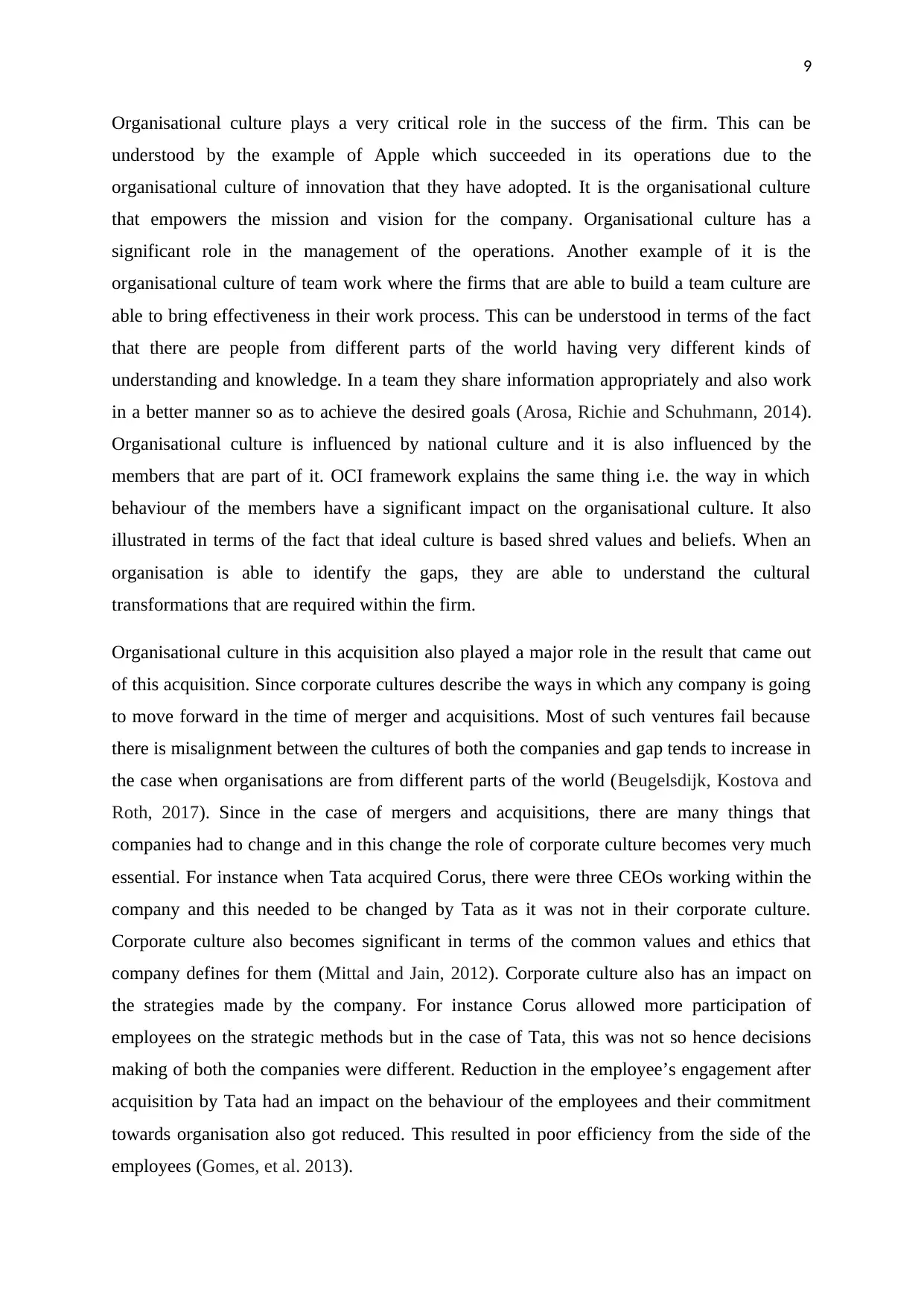
9
Organisational culture plays a very critical role in the success of the firm. This can be
understood by the example of Apple which succeeded in its operations due to the
organisational culture of innovation that they have adopted. It is the organisational culture
that empowers the mission and vision for the company. Organisational culture has a
significant role in the management of the operations. Another example of it is the
organisational culture of team work where the firms that are able to build a team culture are
able to bring effectiveness in their work process. This can be understood in terms of the fact
that there are people from different parts of the world having very different kinds of
understanding and knowledge. In a team they share information appropriately and also work
in a better manner so as to achieve the desired goals (Arosa, Richie and Schuhmann, 2014).
Organisational culture is influenced by national culture and it is also influenced by the
members that are part of it. OCI framework explains the same thing i.e. the way in which
behaviour of the members have a significant impact on the organisational culture. It also
illustrated in terms of the fact that ideal culture is based shred values and beliefs. When an
organisation is able to identify the gaps, they are able to understand the cultural
transformations that are required within the firm.
Organisational culture in this acquisition also played a major role in the result that came out
of this acquisition. Since corporate cultures describe the ways in which any company is going
to move forward in the time of merger and acquisitions. Most of such ventures fail because
there is misalignment between the cultures of both the companies and gap tends to increase in
the case when organisations are from different parts of the world (Beugelsdijk, Kostova and
Roth, 2017). Since in the case of mergers and acquisitions, there are many things that
companies had to change and in this change the role of corporate culture becomes very much
essential. For instance when Tata acquired Corus, there were three CEOs working within the
company and this needed to be changed by Tata as it was not in their corporate culture.
Corporate culture also becomes significant in terms of the common values and ethics that
company defines for them (Mittal and Jain, 2012). Corporate culture also has an impact on
the strategies made by the company. For instance Corus allowed more participation of
employees on the strategic methods but in the case of Tata, this was not so hence decisions
making of both the companies were different. Reduction in the employee’s engagement after
acquisition by Tata had an impact on the behaviour of the employees and their commitment
towards organisation also got reduced. This resulted in poor efficiency from the side of the
employees (Gomes, et al. 2013).
Organisational culture plays a very critical role in the success of the firm. This can be
understood by the example of Apple which succeeded in its operations due to the
organisational culture of innovation that they have adopted. It is the organisational culture
that empowers the mission and vision for the company. Organisational culture has a
significant role in the management of the operations. Another example of it is the
organisational culture of team work where the firms that are able to build a team culture are
able to bring effectiveness in their work process. This can be understood in terms of the fact
that there are people from different parts of the world having very different kinds of
understanding and knowledge. In a team they share information appropriately and also work
in a better manner so as to achieve the desired goals (Arosa, Richie and Schuhmann, 2014).
Organisational culture is influenced by national culture and it is also influenced by the
members that are part of it. OCI framework explains the same thing i.e. the way in which
behaviour of the members have a significant impact on the organisational culture. It also
illustrated in terms of the fact that ideal culture is based shred values and beliefs. When an
organisation is able to identify the gaps, they are able to understand the cultural
transformations that are required within the firm.
Organisational culture in this acquisition also played a major role in the result that came out
of this acquisition. Since corporate cultures describe the ways in which any company is going
to move forward in the time of merger and acquisitions. Most of such ventures fail because
there is misalignment between the cultures of both the companies and gap tends to increase in
the case when organisations are from different parts of the world (Beugelsdijk, Kostova and
Roth, 2017). Since in the case of mergers and acquisitions, there are many things that
companies had to change and in this change the role of corporate culture becomes very much
essential. For instance when Tata acquired Corus, there were three CEOs working within the
company and this needed to be changed by Tata as it was not in their corporate culture.
Corporate culture also becomes significant in terms of the common values and ethics that
company defines for them (Mittal and Jain, 2012). Corporate culture also has an impact on
the strategies made by the company. For instance Corus allowed more participation of
employees on the strategic methods but in the case of Tata, this was not so hence decisions
making of both the companies were different. Reduction in the employee’s engagement after
acquisition by Tata had an impact on the behaviour of the employees and their commitment
towards organisation also got reduced. This resulted in poor efficiency from the side of the
employees (Gomes, et al. 2013).
Paraphrase This Document
Need a fresh take? Get an instant paraphrase of this document with our AI Paraphraser
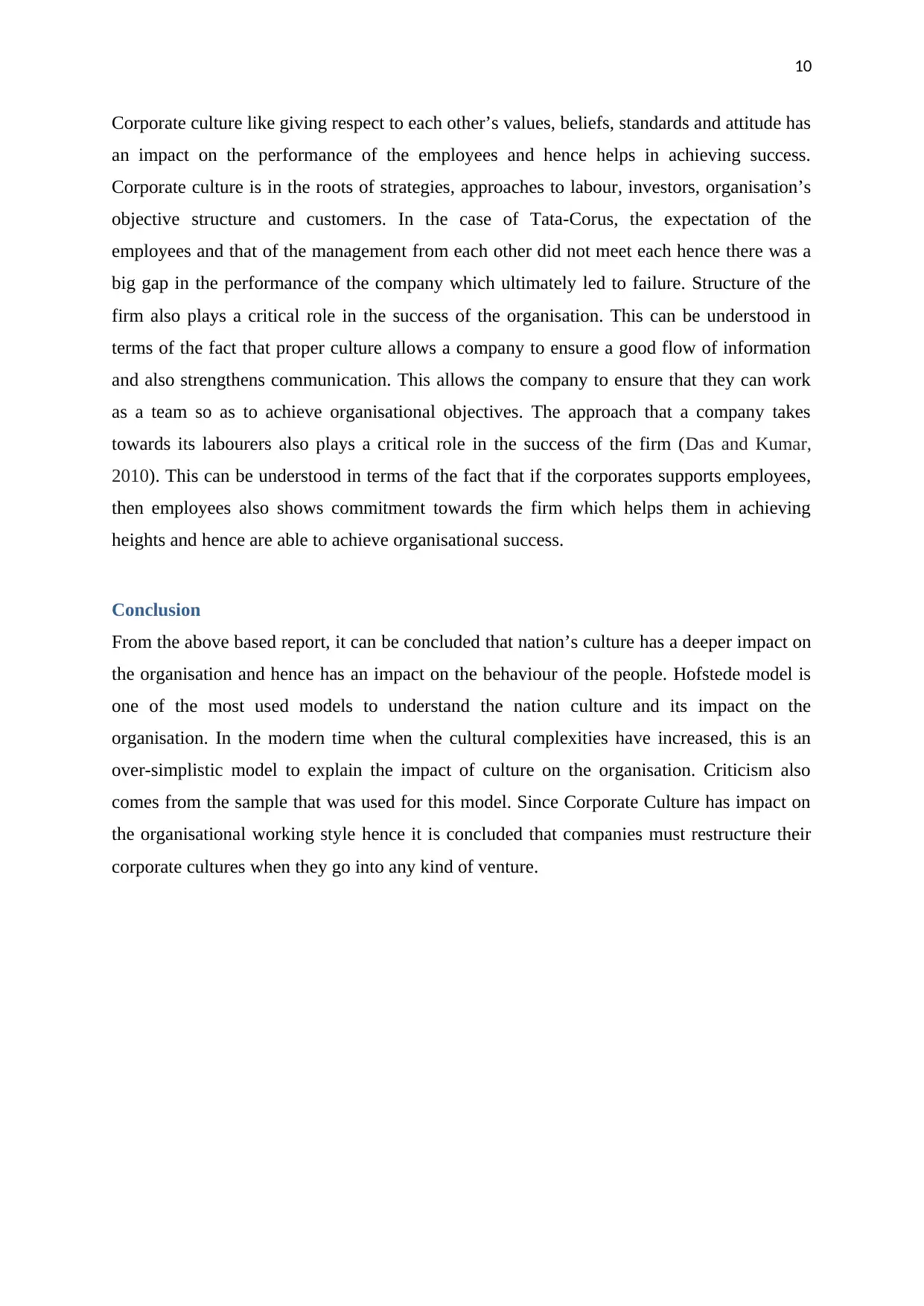
10
Corporate culture like giving respect to each other’s values, beliefs, standards and attitude has
an impact on the performance of the employees and hence helps in achieving success.
Corporate culture is in the roots of strategies, approaches to labour, investors, organisation’s
objective structure and customers. In the case of Tata-Corus, the expectation of the
employees and that of the management from each other did not meet each hence there was a
big gap in the performance of the company which ultimately led to failure. Structure of the
firm also plays a critical role in the success of the organisation. This can be understood in
terms of the fact that proper culture allows a company to ensure a good flow of information
and also strengthens communication. This allows the company to ensure that they can work
as a team so as to achieve organisational objectives. The approach that a company takes
towards its labourers also plays a critical role in the success of the firm (Das and Kumar,
2010). This can be understood in terms of the fact that if the corporates supports employees,
then employees also shows commitment towards the firm which helps them in achieving
heights and hence are able to achieve organisational success.
Conclusion
From the above based report, it can be concluded that nation’s culture has a deeper impact on
the organisation and hence has an impact on the behaviour of the people. Hofstede model is
one of the most used models to understand the nation culture and its impact on the
organisation. In the modern time when the cultural complexities have increased, this is an
over-simplistic model to explain the impact of culture on the organisation. Criticism also
comes from the sample that was used for this model. Since Corporate Culture has impact on
the organisational working style hence it is concluded that companies must restructure their
corporate cultures when they go into any kind of venture.
Corporate culture like giving respect to each other’s values, beliefs, standards and attitude has
an impact on the performance of the employees and hence helps in achieving success.
Corporate culture is in the roots of strategies, approaches to labour, investors, organisation’s
objective structure and customers. In the case of Tata-Corus, the expectation of the
employees and that of the management from each other did not meet each hence there was a
big gap in the performance of the company which ultimately led to failure. Structure of the
firm also plays a critical role in the success of the organisation. This can be understood in
terms of the fact that proper culture allows a company to ensure a good flow of information
and also strengthens communication. This allows the company to ensure that they can work
as a team so as to achieve organisational objectives. The approach that a company takes
towards its labourers also plays a critical role in the success of the firm (Das and Kumar,
2010). This can be understood in terms of the fact that if the corporates supports employees,
then employees also shows commitment towards the firm which helps them in achieving
heights and hence are able to achieve organisational success.
Conclusion
From the above based report, it can be concluded that nation’s culture has a deeper impact on
the organisation and hence has an impact on the behaviour of the people. Hofstede model is
one of the most used models to understand the nation culture and its impact on the
organisation. In the modern time when the cultural complexities have increased, this is an
over-simplistic model to explain the impact of culture on the organisation. Criticism also
comes from the sample that was used for this model. Since Corporate Culture has impact on
the organisational working style hence it is concluded that companies must restructure their
corporate cultures when they go into any kind of venture.
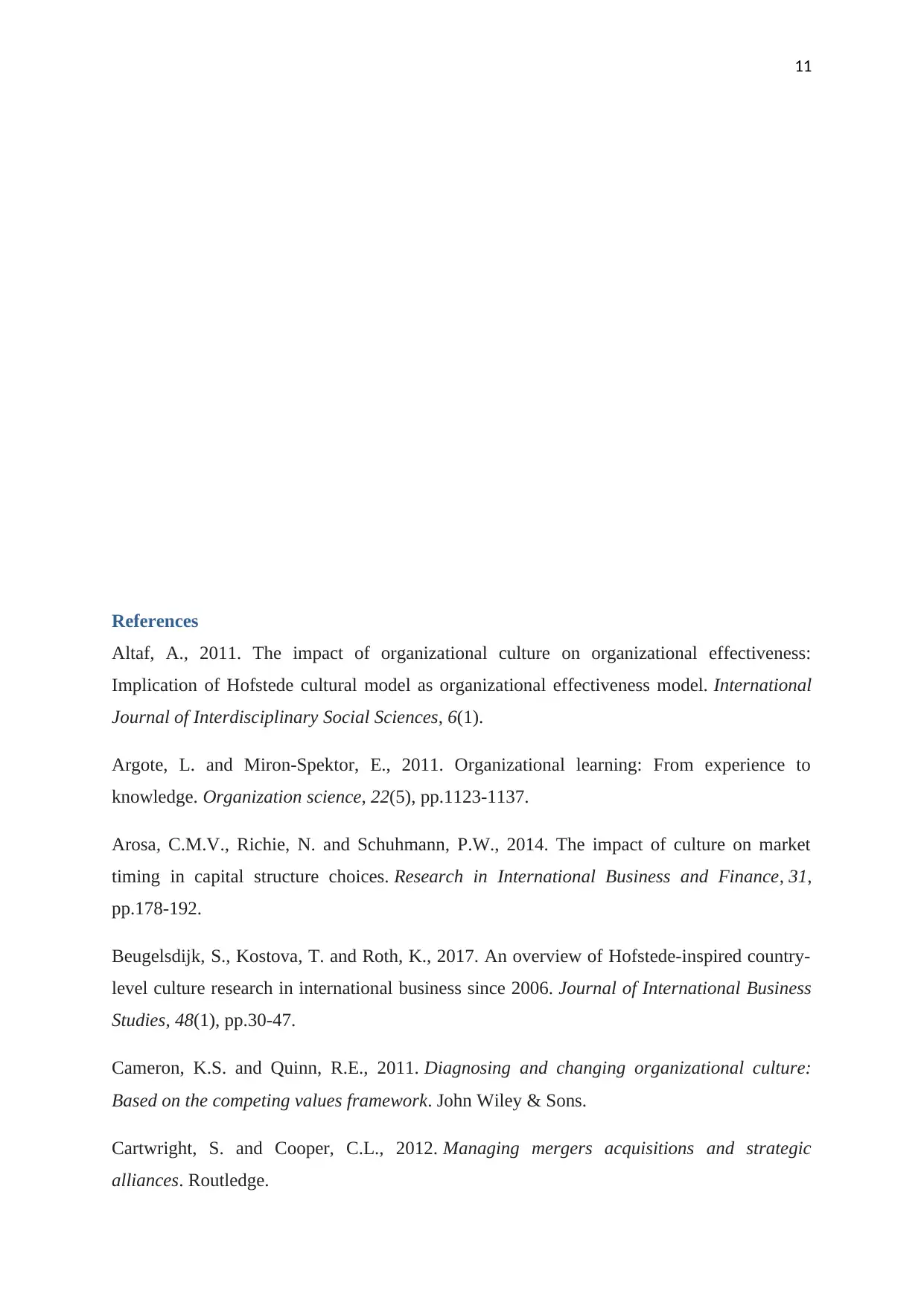
11
References
Altaf, A., 2011. The impact of organizational culture on organizational effectiveness:
Implication of Hofstede cultural model as organizational effectiveness model. International
Journal of Interdisciplinary Social Sciences, 6(1).
Argote, L. and Miron-Spektor, E., 2011. Organizational learning: From experience to
knowledge. Organization science, 22(5), pp.1123-1137.
Arosa, C.M.V., Richie, N. and Schuhmann, P.W., 2014. The impact of culture on market
timing in capital structure choices. Research in International Business and Finance, 31,
pp.178-192.
Beugelsdijk, S., Kostova, T. and Roth, K., 2017. An overview of Hofstede-inspired country-
level culture research in international business since 2006. Journal of International Business
Studies, 48(1), pp.30-47.
Cameron, K.S. and Quinn, R.E., 2011. Diagnosing and changing organizational culture:
Based on the competing values framework. John Wiley & Sons.
Cartwright, S. and Cooper, C.L., 2012. Managing mergers acquisitions and strategic
alliances. Routledge.
References
Altaf, A., 2011. The impact of organizational culture on organizational effectiveness:
Implication of Hofstede cultural model as organizational effectiveness model. International
Journal of Interdisciplinary Social Sciences, 6(1).
Argote, L. and Miron-Spektor, E., 2011. Organizational learning: From experience to
knowledge. Organization science, 22(5), pp.1123-1137.
Arosa, C.M.V., Richie, N. and Schuhmann, P.W., 2014. The impact of culture on market
timing in capital structure choices. Research in International Business and Finance, 31,
pp.178-192.
Beugelsdijk, S., Kostova, T. and Roth, K., 2017. An overview of Hofstede-inspired country-
level culture research in international business since 2006. Journal of International Business
Studies, 48(1), pp.30-47.
Cameron, K.S. and Quinn, R.E., 2011. Diagnosing and changing organizational culture:
Based on the competing values framework. John Wiley & Sons.
Cartwright, S. and Cooper, C.L., 2012. Managing mergers acquisitions and strategic
alliances. Routledge.
⊘ This is a preview!⊘
Do you want full access?
Subscribe today to unlock all pages.

Trusted by 1+ million students worldwide
1 out of 14
Related Documents
Your All-in-One AI-Powered Toolkit for Academic Success.
+13062052269
info@desklib.com
Available 24*7 on WhatsApp / Email
![[object Object]](/_next/static/media/star-bottom.7253800d.svg)
Unlock your academic potential
Copyright © 2020–2025 A2Z Services. All Rights Reserved. Developed and managed by ZUCOL.





